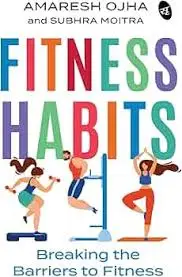
Fitness Habits
Breaking the Barriers to Fitness
Amaresh Ojha & Subhra Moitra
Srishti Publishers (2021)
- Physical
- Book, Premium Content, Resource Summary
Key Takeaways
- Start tiny, stay steady. Two-minute “starter” workouts anchor a habit without draining precious energy.
- Use the cue-routine-reward loop. Attach movement to an obvious daily cue—then celebrate each completion to lock in dopamine-powered motivation.
- Give it 12 weeks. Research shows fitness habits need about three months of consistency before they feel automatic.
- Shape your surroundings. Friendly workout spaces, supportive people and visible gear make the healthy choice the easy choice.
Click to read full summary
The Essentials
Fitness Habits demystifies how ordinary people can turn exercise from a sporadic chore into an effortless part of daily life. Drawing on habit-formation science and data from Indian gyms, the authors explain why 60 % of beginners quit within two months—and how to beat those odds with simple, rewarding routines.
For the FND community, the book’s focus on behavior change over brute willpower is key. Instead of prescribing intense programs that can provoke symptom flares, it teaches scalable actions (even two-minute sessions) that respect fluctuating energy, reduce stress, and promote nervous-system regulation. By framing movement as a source of intrinsic pleasure—not punishment—Fitness Habits offers a practical path toward sustainable physical and emotional wellbeing.
Why This Matters for FND
Regular, gentle movement is linked to improved mood regulation, reduced functional symptoms and better sleep—yet many people with FND struggle to begin or maintain an exercise routine amid fatigue, pain or motor episodes. This book:
- Breaks habit formation into brain-friendly micro-steps that remain doable on low-capacity days.
- Highlights social and environmental tweaks (e.g., exercising with a friend, laying out clothes) shown to boost follow-through even when motivation dips.
- Emphasizes internal rewards—such as the post-exercise calm FND individuals often notice—helping movement become self-reinforcing over time.
Resource Qualities
Applicability:
Accessibility:
Evidence-Based:
Practical Value:
Practical Applications
For Individuals with FND
Low-Energy Days
- Do a two-minute seated stretch or gentle breath-paired arm raises right after morning tea—enough to keep the habit loop alive without overtaxing the system.
Building Long-Term Wellness
- Link a daily cue (e.g., finishing lunch) to a gradually lengthening walk, tracking small wins in a journal to stimulate dopamine and reinforce progress.
For Care Partners
Supporting Your Loved One
- Offer to join the two-minute routine or cue it with a shared timer; praise completion rather than intensity.
- Help create a motivating environment: place resistance bands in view, schedule joint walks, or arrange transport to an accessible gym class.
Caring for Yourself
- Use the same micro-habit principles to add your own stress-relieving movement, modeling self-care and sustaining caregiver resilience.
When This is Most Helpful
- Newly diagnosed individuals seeking safe, manageable ways to move.
- Symptom-management phases where consistency outweighs intensity.
- Care partners looking for concrete, low-burden support strategies.
This summary is provided for informational purposes only and does not constitute medical, financial, or legal advice. It is not intended to replace professional consultation or treatment. Always consult qualified providers regarding your specific circumstances, symptoms, or questions.
